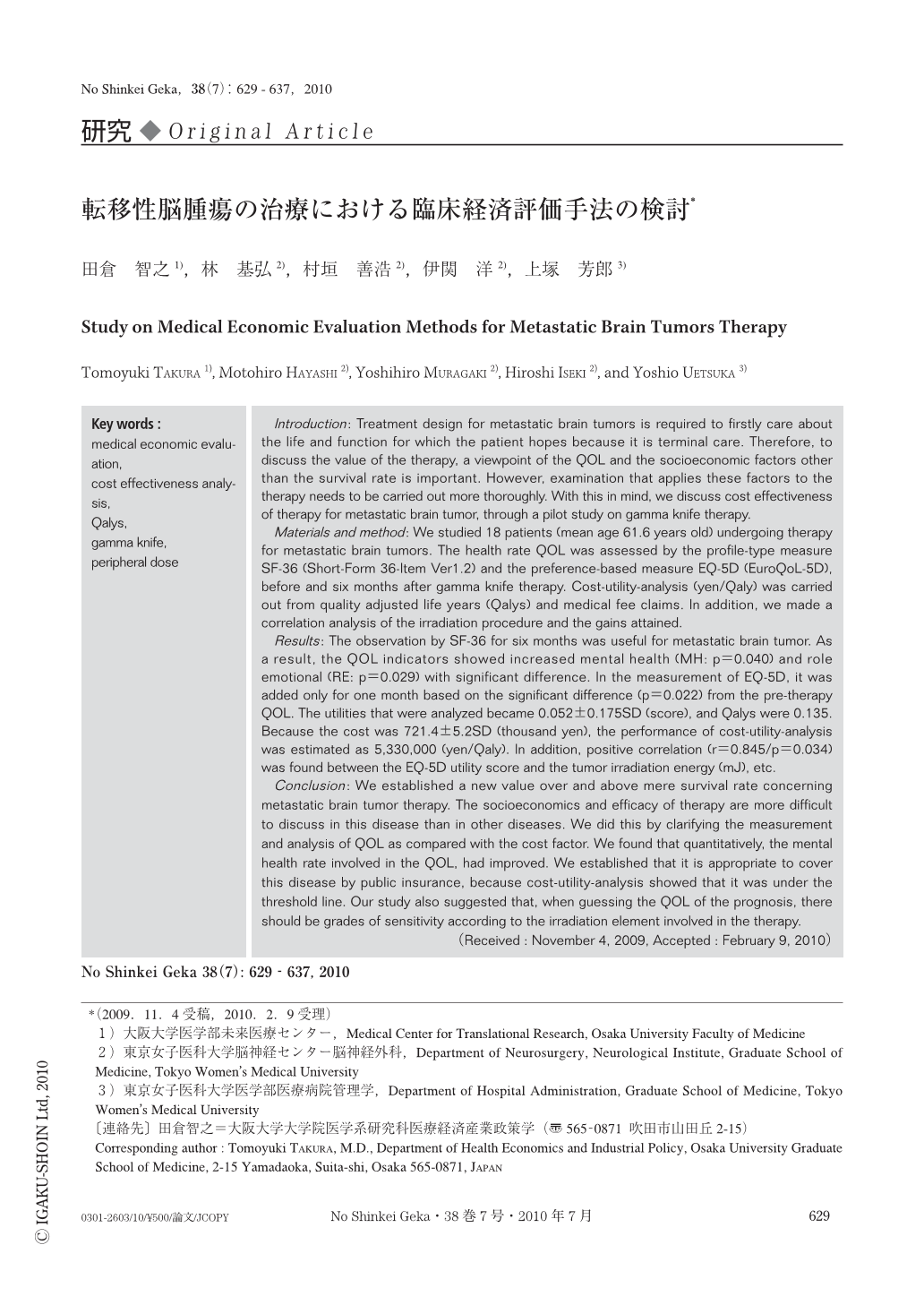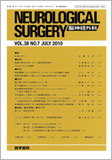Japanese
English
- 有料閲覧
- Abstract 文献概要
- 1ページ目 Look Inside
- 参考文献 Reference
Ⅰ.はじめに
転移性脳腫瘍については,単発脳転移などを中心に外科手術と放射線全脳照射の併用療法,および全脳照射の単独療法,または定位的放射線手術(stereotactic radiosurgery)と全脳照射の併用療法など,治療選択のあり方についてさまざまな議論が行われている1,6,13,20,22,24,32,33).これらの検討では生存率を1つの指標に挙げているが,終末期に近く中央生存期間が1年間程度と比較的短い疾病機序などを背景に,おのおのの治療法が有する価値を十分に論じるには,生活の質(QOL:quality of life)や診療の経済性などを加味した多面的な検討も必要となる.しかし,現在行われている多施設共同研究や転移性脳腫瘍治療に関する現存の報告においても,生存率や腫瘍コントロール率(progression free survival rate)などは言及されているが,生活の質や臨床経済的な観点での有用性に関する報告は見当たらない.
最近は,このような臨床経済的な観点による研究も普及しつつある.例えば,QOLを定量化した効用(utility)と診療に係わる費用(cost)の比から,診療技術の臨床経済的な価値(診療パフォーマンス)を論じる費用対効用分析(cost-utility-analysis)などがある.このような研究成果を蓄積することは,外科手術や全脳照射,または定位的放射線手術などの社会的な意義をさらに示すことになり,わが国の医療システムの中で当該診療技術の適切な普及を促すと考えられる.一方で,転移性脳腫瘍の領域でこの臨床経済的な価値を整理していくためには,次に示す手法自体の検証が必要となる.例えば,転移性脳腫瘍に対して患者の効用値を測定することが可能なのか,また測定されたその効用値は疾病特性と整合性を有するのか,などである.転移性脳腫瘍に対するこのような研究は,国内でまだ十分でなく臨床面のみならず制度面からも期待が高いと思われる.
そこでわれわれは,転移性脳腫瘍の治療における臨床経済学的な評価手法の検討を目的に,予備的研究(pilot study)を試行した.なお,手法の有用性の検討が目的なため,手技の複雑性や運用上のバイアスが比較的少なく,さらに有害事象の管理もできるだけ可能な療法と症例を選択することが,本研究の条件として重要であった.このような観点から,定位的放射線手術の1つであるガンマナイフ治療(gamma knife surgery)を選び,その一般的な症例について検討を進めた.
ガンマナイフ治療は,201個のコバルト(Co60)が線源となり半円球状かつ同心円状に配置され,それぞれから放出されたガンマ線がその中心に集束するよう設計されている.このガンマナイフの脳腫瘍に対する治療は,介入できる病巣の大きさに制限があるものの,侵襲性が低いため,全身麻酔に耐えられないような患者の治療も可能な上,比較的治療リスクが少ないとされる25,35).実際,わが国における定位的放射線手術の最大の適応は転移性脳腫瘍であり,各施設の治療適応疾患の多くを占めている.一方で,従来の放射線治療と同様,被照射線量(Gy)のみを基準とした治療計画が一般的とされており,高線量一括照射ゆえに照射体積などを考慮した治療プロトコール(腫瘍もしくは周囲正常脳への被照射体積や辺縁線量など)は完全に確立されたとはまだ言えない状況にある10,16).そのため,放射線障害に伴う脳浮腫などの有害事象や腫瘍再発の管理が的確に行えず,患者QOLなどの低下や医療費の増加が懸念されるケースも散見しており,単に照射量だけにとどまらない,新たな照射方法に関するパラメータの開発と検討が急務となっている.例えば,線量勾配の均一化のみならず,標的外の線量減衰の急峻さに対する配慮も重要と言える.今後は,臨床経済性にも考慮しつつ,照射方法のさらなる発展が期待される.
以上の点を踏まえ,本研究では,転移性脳腫瘍に対する臨床経済評価を推進させる予備的研究として,ガンマナイフ手技で転移性脳腫瘍治療の費用対効果分析の可能性を確認するとともに,患者QOLへの貢献度,臨床経済学的な有効性,そして治療法によるそれらの差異について検討を行ったので,若干の文献考察を加え報告をする.
Introduction: Treatment design for metastatic brain tumors is required to firstly care about the life and function for which the patient hopes because it is terminal care. Therefore,to discuss the value of the therapy,a viewpoint of the QOL and the socioeconomic factors other than the survival rate is important. However,examination that applies these factors to the therapy needs to be carried out more thoroughly. With this in mind,we discuss cost effectiveness of therapy for metastatic brain tumor,through a pilot study on gamma knife therapy.
Materials and method: We studied 18 patients (mean age 61.6 years old) undergoing therapy for metastatic brain tumors. The health rate QOL was assessed by the profile-type measure SF-36 (Short-Form 36-Item Ver1.2) and the preference-based measure EQ-5D (EuroQoL-5D), before and six months after gamma knife therapy. Cost-utility-analysis (yen/Qaly) was carried out from quality adjusted life years (Qalys) and medical fee claims. In addition, we made a correlation analysis of the irradiation procedure and the gains attained.
Results: The observation by SF-36 for six months was useful for metastatic brain tumor. As a result, the QOL indicators showed increased mental health (MH: p=0.040) and role emotional (RE: p=0.029) with significant difference. In the measurement of EQ-5D, it was added only for one month based on the significant difference (p=0.022) from the pre-therapy QOL. The utilities that were analyzed became 0.052±0.175SD (score), and Qalys were 0.135. Because the cost was 721.4±5.2SD (thousand yen), the performance of cost-utility-analysis was estimated as 5,330,000 (yen/Qaly). In addition, positive correlation (r=0.845/p=0.034) was found between the EQ-5D utility score and the tumor irradiation energy (mJ), etc.
Conclusion: We established a new value over and above mere survival rate concerning metastatic brain tumor therapy. The socioeconomics and efficacy of therapy are more difficult to discuss in this disease than in other diseases. We did this by clarifying the measurement and analysis of QOL as compared with the cost factor. We found that quantitatively,the mental health rate involved in the QOL,had improved. We established that it is appropriate to cover this disease by public insurance,because cost-utility-analysis showed that it was under the threshold line. Our study also suggested that,when guessing the QOL of the prognosis,there should be grades of sensitivity according to the irradiation element involved in the therapy.

Copyright © 2010, Igaku-Shoin Ltd. All rights reserved.


